Last Updated on May 11, 2023 by Dee
The pen ink and watercolor combination is one of my absolute favorite mixed mediums to work in. It combines the contrast of opaque solid pen or ink marks and the flowing, light quality of watercolor paint.
We can say they are almost opposite each other in their aesthetic, with ink pen adding structure to the dreamlike watercolor medium.
This combination is often used in an artwork by drawing with the pen or ink and coloring the image through watercolor washes.
If you have a look on Pinterest or google “pen ink and watercolor”, you will come across the most beautiful, and whimsical artwork.
Perhaps that is why you are reading this article right now…you have spotted something that stirred your imagination and made you want to explore it more and maybe even try it out?
Well, you’re in the right place – I have made sure to include loads of helpful tips and tricks to help you start you own pen ink and watercolor artwork!
Pen ink and watercolor art lends itself to art forms like illustration and can have a strong vintage quality to it. Because of this, many artists use it to illustrate images in their junk journals, art journals or even travel journals.
It is actually a great combination to use when you are out and about because its portable and easy to slip out of your bag and do a quick sketch.
People use this combination to paint or illustrate a huge variety of subject matter from landscapes, portraits, botanicals, cityscapes, figure studies, concept art and on an on it goes.
And because these two mediums go so well together they often leave a very professional finish.
So, you have come across this art medium combo and are desperate to try it out?
That’s great news! But like with any new art medium, it’s a good idea to do a bit of research beforehand and make sure you know what materials and tools to use, and, of course, how the mediums work together.
Make sure to go over my list of tips and tricks below so you know what problems to avoid and how to begin your artwork.
**This page may contain affiliate links to products I have used or recommend. If you purchase something from this page, I may receive a small percentage of the sale at no extra cost to you.**
Pen Ink & Watercolor Painting Techniques
Method A: You can draw with pen or ink first and then use watercolor over it.
This is a useful method to use if you prefer to draw the structure of your subject matter first and then fill in areas with watercolor washes.
You can start out by drawing your outline in 2B pencil, and then go over it with pen ink. You can then erase the pencil marks before you start painting the watercolor washes over the pen.
Artists often paint a splash of color loosely in the area where the ink drawing is. This gives an ephemeral and almost impressionistic feeling to the artwork. This can also help draw the viewer’s attention to a point of interest in the piece.
[Related Article: Watercolor Pencil vs Paint – Which One Should You Use?]
Use pens that are waterproof or water-resistant.
If you use your standard fine liner pen or marker, as soon as the watercolor paint touches the pen line, the ink will smudge and bleed into the watercolor.
This will create a messy situation – and unless that’s what you are going for, make sure you have the right pens! If you want to paint over your pen ink with watercolor or water-based paint avoid using water-soluble or water-based inks.
Waterproof pens and ink are the ideal choice because the ink does not bleed, lift or smudge when you work over it or paint over it. This means that you can start painting immediately after drawing your subject matter.
Water-resistant pens take some time to dry before they are safe to paint over with watercolor paint.
[15 Best Pencil Cases for Artists & How you Should Choose One]
Method B: You can paint with watercolor first and then draw on top of it with pen and ink.
In this method the watercolor guides the artmaking path.
You can choose to paint abstract shapes and then draw objects or realistic subject matter on top of the watercolor, or you can paint realistic shapes of forms and then use your pen to create shadow, form and shape.
You can use your pen to outline the watercolor.
Some people say that they pen ink loses its vibrancy because of the watercolor on top of it, but to be honest, I have never found that it makes much of a difference – especially when you are using black ink.
You can really use any type of marker or pen for this method – this is especially helpful if you only have a water-soluble pen on hand!
However, you must make sure that your watercolor paint is completely dry before you draw over it. I recommend that you wait for 24 hours before you use ink over your watercolor.
Although it can be frustrating to have to stop your art making flow, it is also really good practice to have a break and time away from making in order to refresh.
Consider also using pens and inks that are archival
Archival pen ink is permanent and is acid-free. This means it is perfect for drawings you intend to sell or art that you want to keep for a very long time – it won’t yellow the paper and it will last for a very long time.
Just remember archival doesn’t always mean waterproof. Often archival inks are water-resistant which means they need some drying time before you paint over them with watercolor. This is usually about 3 hours.
I mostly use Faber Castell Pitt Pens and they are an incredibly popular choice for good reason. I recently did some pen and watercolor doodling and found that they dried instantly and so once I had completed the ink drawing, I could then immediately paint over it with watercolor.
Micron Pens are also at the top of my list and are an excellent pen to use in combination with watercolor. They take slightly longer to dry (about 3 hours) than the Pitt Pens, but they are archival and of the highest quality. They are superb pens to work with.
[Related article: 50 Things To Draw on Your Hand]
Use a test strip of watercolor paper before you begin.
When you start out using any new art medium it is always a good idea to test it out and play before you begin. By doing this you get a sense of what you can actually do with the medium and it helps to build your confidence for when you start making art.
Some of my best ideas have come from test strips!
Test out the different pens, markers and inks you have both before and after your watercolor washes.
Implement Pen Shading Techniques
If you have chosen a subject you want to realistically portray, it’s a good idea to get the lighting and shadows drawn accurately.
This is where shading techniques come into play. Test out your shading techniques like hatching, cross-hatching, stippling and scribbling to build up your shadow areas and create depth in your artwork.
Use the correct paper
If you are going to do any sort of painting, you have to work on a heavier paper that can hold the water and paint. Just think about when you have spilt water on a piece of standard printer paper… it buckles and changes shape.
I would recommend getting yourself some watercolor paper, or a watercolor journal or pad. My favorite paper is Strathmore cold pressed 300gsm pad. It has a slightly textured surface and easily holds ink and watercolor washes.
Other materials and tools to consider when using pen ink and watercolor
Use watercolor over sharpies
Sharpie markers are truly awesome and you can do so much with them. They are permanent markers which means you can easily paint over them with watercolor without smudging the ink.
They are a lot chunkier than Pitt pens or Micron pens, so bear that in mind when you are planning your drawing.
Permanent Gel Pens
Gel pens are another medium you can use both underneath and over watercolor paint.
You can create incredibly bright and bold lines with them and they come in a range of great colors which can add a whole other dimension to your work. Some even come in metallic or glitter ink.
Just remember to let them dry thoroughly before you paint over them. Uniball’s Gel pens use something called ‘super ink’ which is considered highly permanent.
Brush Pens
A brush pen has a brush-like tip and creates flowing, brush-like marks. They work really well in combination with watercolor painting and are a nice tool to have.
Like other pens you can get both water-soluble and waterproof brush pens.
The Pentel Pocket Brush Pen is one of the more popular waterproof brush pens. It has an intensely dark ink and dries very quickly.
The Arteza Real Brush Pens come in a range of bright colors and are water-soluble. They can be used in combination with watercolor paint by blending them into the watercolor wet on wet, or by drawing over the watercolor once dry.
Recommended Inks (in a bottle)
Winsor and Newton Drawing Ink is an excellent quality water-soluble ink that is water-resistant when dry and has a pitch-black appearance. You can also choose to use the India ink variation which has more of a brown/black color to it.
Speedball Black India Ink is one of my favorite drawing inks. It has a rich, opaque black color and is permanent and waterproof. It also is non-clogging – this means it works really well if you are using a fountain pen.
Daler Rowney Black Acrylic Ink is a pigmented (permanent) water-resistant ink which is highly rated for drawing.
Fountain Pens to use with bottled ink
To use a fountain pen you have to fill it with ink and continue to fill it up when the ink runs out.
The Lamy Safari Fountain Pen is one of the best fountain pens for art-making of all sorts including calligraphy. It is durable and produces a beautifully smooth, even line.
Here is a great video on how to fill your Lamy fountain pen.
Best Drawing Ink for Fountain Pens
If you want to use a fountain pen for your ink drawing you can use both water-soluble or waterproof ink. However, waterproof ink does tend to clog the pen as it ages. Make sure to clean your fountain pen regularly.
Here are concise instructions on how to clean your fountain pen.
Pelican Fount India Ink is one of the best water-resistant inks to use in a fountain pen. It allows you to build tonal value in your drawing but is also a very deep black ink.
Dr. Ph. Martin’s Tech Drawing Ink is an excellent waterproof ink if you are taking your ink and watercolor art more seriously. It is archival and lightfast and it comes in a range of vibrant colors to work with, like daffodil, orange, olive green, and gold ochre – to name just a few. You can also mix the colors to create new hues.
Remember you can draw with ink using a variety of found tools at home in your own environment
String
This is great to dip into ink and drag or pull along the surface of your paper in order to create abstract or expressive marks and forms.
A broken twig
Dip your twig into your ink and used as a drawing implement. You can get a lovely sketchy effect because of the bristle-like tip of the broken twig.
Straws
Use a straw for blowing the ink into strange and wonderful networks or web-like patterns.
Bamboo Dip Pens
If you want to take your dipping ink techniques one step further you can get Bamboo Dip Pens which are another great tool that you can purchase if you want to dip a sharper object into ink and create more defined drawings.
Glass Dip Pens
Not only can you create lovely smooth lines with glass dip pens, they also feel great to hold.
Quill pens
Influenced by centuries past quill pens are often used to create an even flowing line of ink for drawing.
Now that we have covered the most important tips and trick for using pen ink and watercolor.
Let’s have a look at what can be done and some examples of pen ink and watercolor art to fire up your imaginations and get your creative juices flowing.
Flowers in Pen ink and watercolor


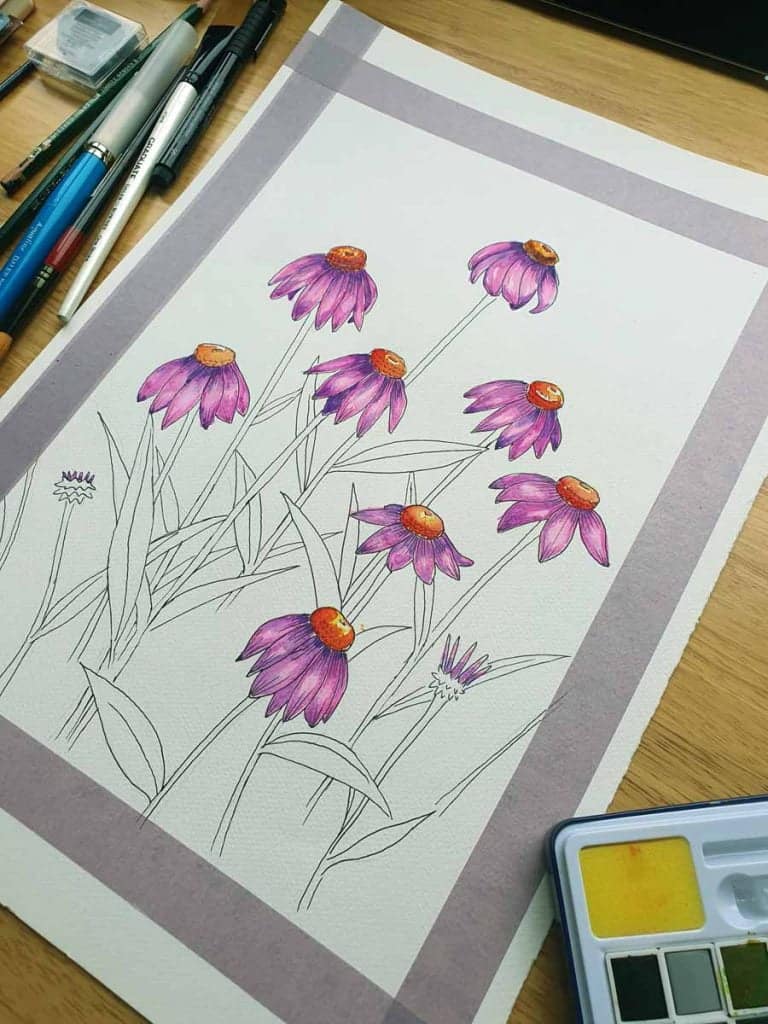
Flowers are a very popular choice of subject matter for this medium. The watercolor paint helps the artist create light and organic petals and other shapes.
The pen helps to define the forms and once again creates a very illustrative finish.
Doodles in Pen and Watercolor

Vintage Storybook Illustration
The pen and watercolor combination has been used for centuries in book illustration. This was a painting done by Arthur Rackham illustrating Act 2 Scene 2 from Shakespeare’s a Midsummer Night’s Dream.
In this painting, we see the classical usage of watercolor and pen where the pen is used to draw the subject matter and the watercolor used to color the objects and shapes.
Sketching landscapes in pen ink and watercolor
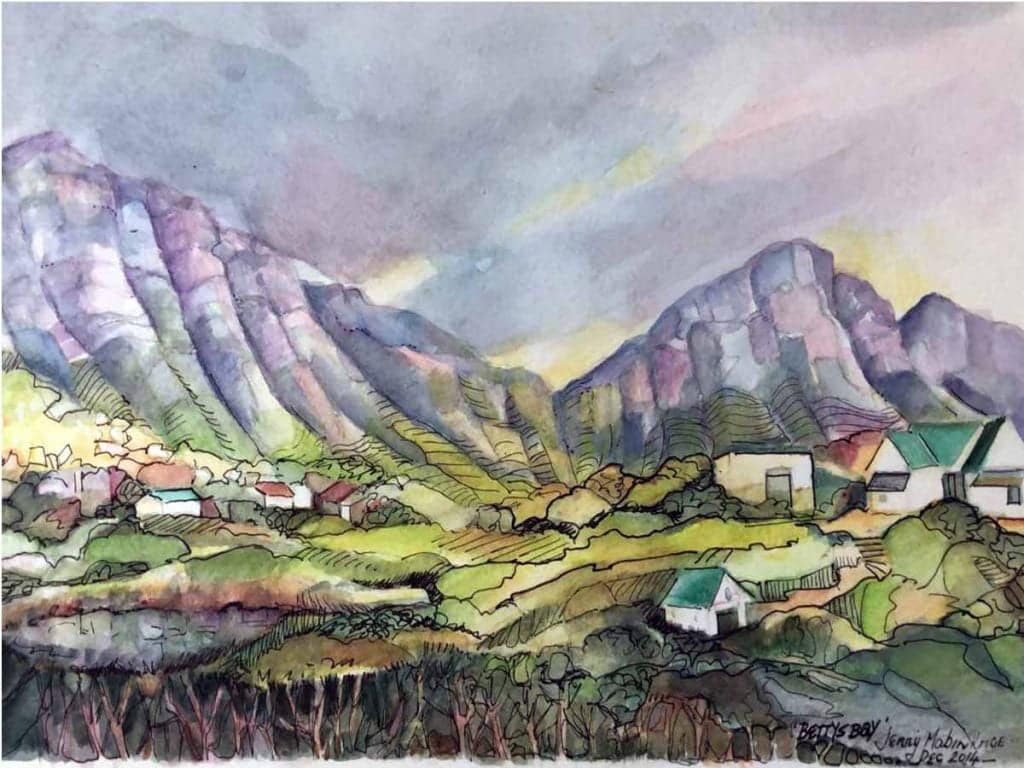
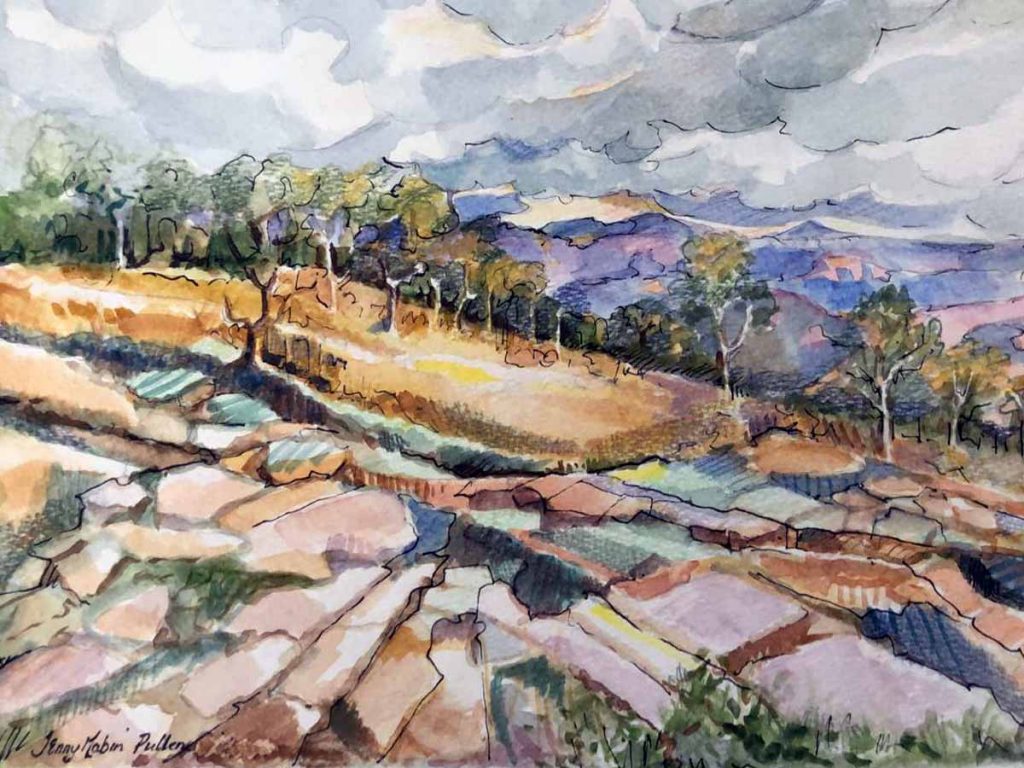
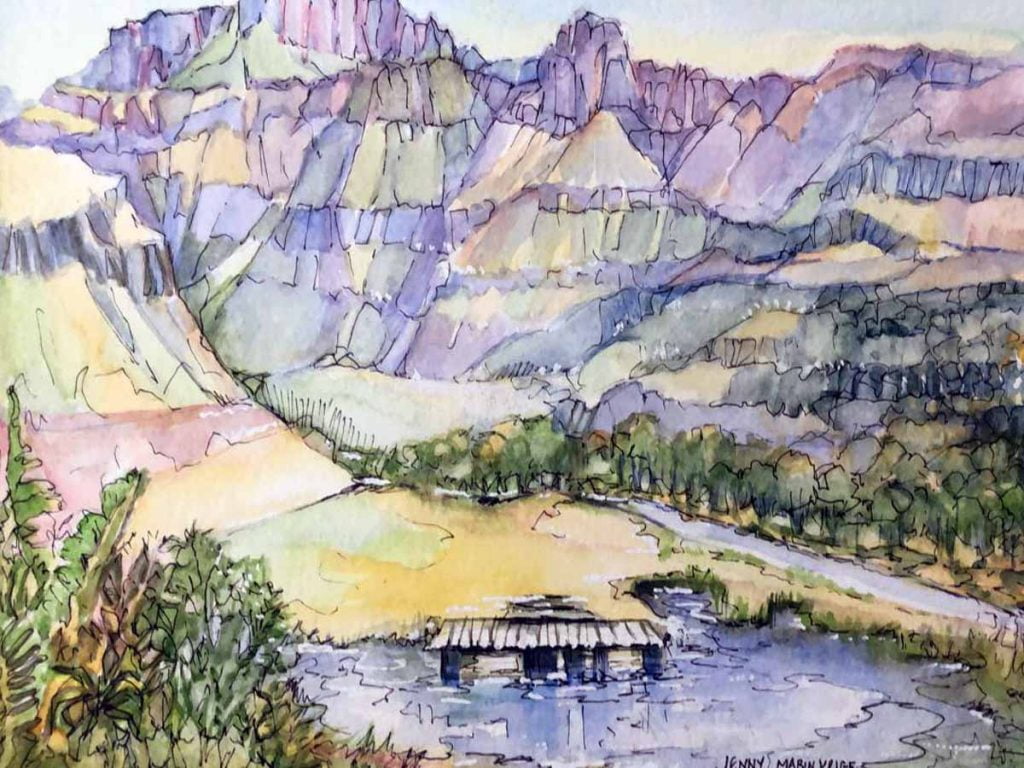
These beautiful paintings were done by Jennifer Mabin-Krige who painted them en plein air in South Africa.
She explained that she starts her paintings by sketching out a light pencil sketch of the scene and then layering watercolor in light washes to build up the various elements of the composition.
Mabin-Krige says the pen outline creates strong structure and both supports and compliments the fluidity of watercolor.
She creates her pieces by painting the composition in watercolor first and then going over areas with her black pen afterward which helps to create textured landscapes.
Quick Tips for Using Pen Ink & Watercolor
Tips for Combining Pen, Ink, and Watercolor in Your Art
- Start with a light pencil sketch: Create an initial sketch with a light graphite pencil to plan your composition and establish the foundation for your watercolor paintings.
- Use waterproof pens: Choose waterproof ink pens to ensure your ink lines don’t smudge or bleed when applying watercolor. Waterproof pens will maintain crisp, pigmented ink lines and provide a professional finish.
- Select pigmented ink pens: Opt for high-quality, pigmented ink pens to create bold, lasting lines that complement your watercolor work. Pigmented ink is less likely to fade over time and will provide a more vibrant result.
- Experiment with line weights: Vary your ink pen line weights to create depth and interest in your artwork. Thicker lines can be used to define main elements, while thinner lines work well for details and shading.
- Apply watercolor washes: Start by applying light watercolor washes over your ink drawing, gradually building up layers to achieve the desired level of color intensity and depth.
- Leave white spaces: When working with watercolor, remember to leave white spaces for highlights and areas of light. This will add contrast and depth to your watercolor paintings.
- Preserve the transparency: One of the unique characteristics of watercolor is its transparency. Use this quality to your advantage by allowing the ink lines to show through and create a harmonious blend between the ink and watercolor layers.
- Allow layers to dry: Before applying more watercolor or ink, make sure your previous layers are completely dry. This will prevent smudging and accidental blending of colors.
- Combine techniques: Experiment with different pen and ink techniques, such as hatching, stippling, and cross-hatching, to create texture and depth within your watercolor paintings.
By incorporating these tips into your art practice, you can create stunning and unique pieces that combine the fluidity of watercolor with the bold lines of pigmented ink pens. Embrace the possibilities of this mixed-media approach to elevate your artwork to new heights.
Conclusion
Pen ink and watercolor are a great combination of mediums to work in and there is so much you can achieve with them. I hope you have a better idea of what you want to achieve in your pen and watercolor art, how you can go about this, and what materials and tools you need to start.
As always, I would love to hear about your art-making process so leave a comment and share your work ?
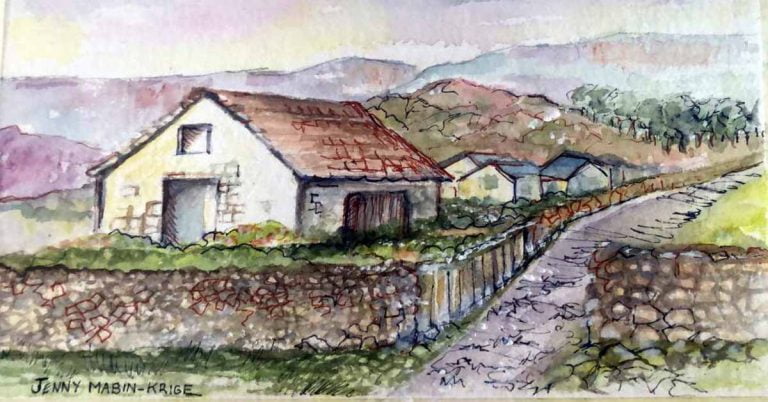
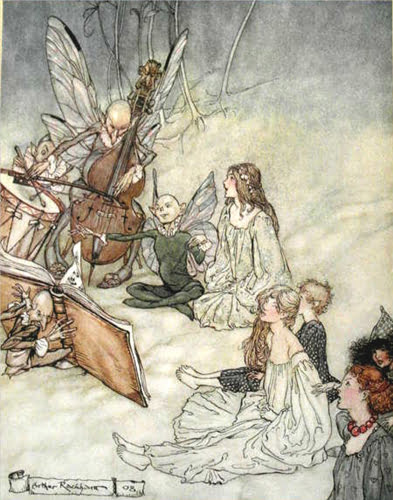
Thank you for this very nice post. I particularly enjoyed the beautiful watercolors by Jenni Mabin Krige – incredible landscapes enhanced by her detailed yet still fluid inking style.
Hi Zelda, I am really glad you enjoyed the post – and especially the beautiful paintings by Jenni Mabin-Krige. Keep checking in because I will including more of her work in future posts 🙂